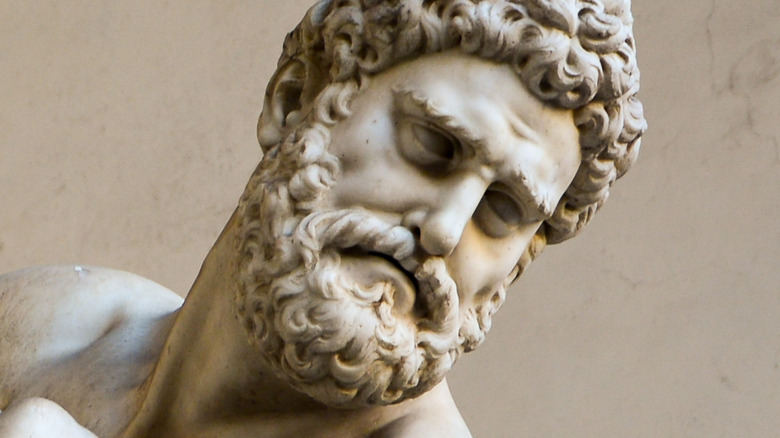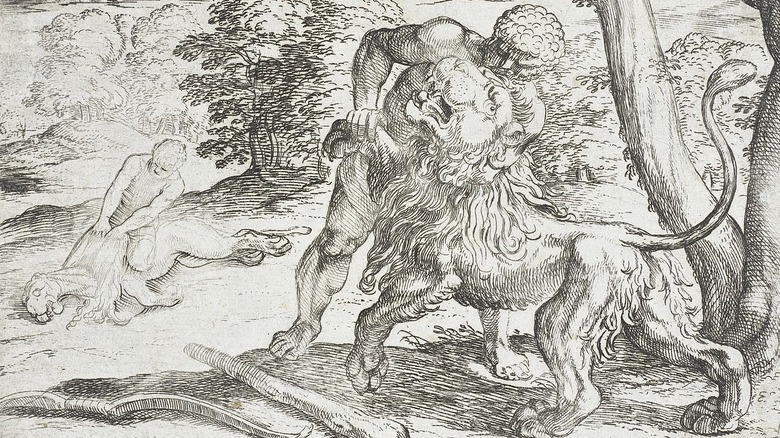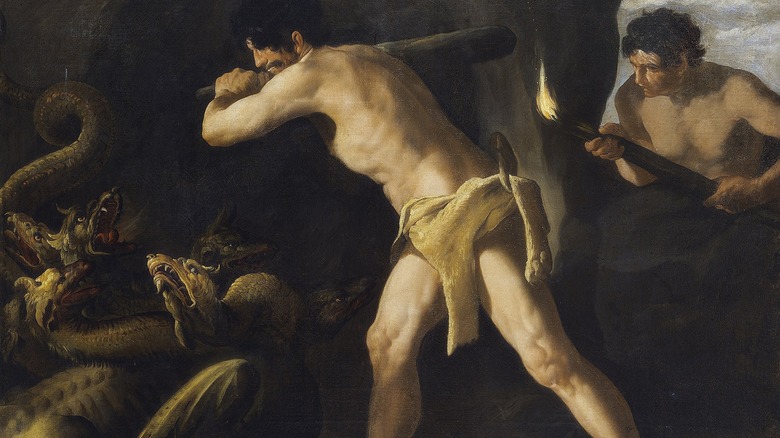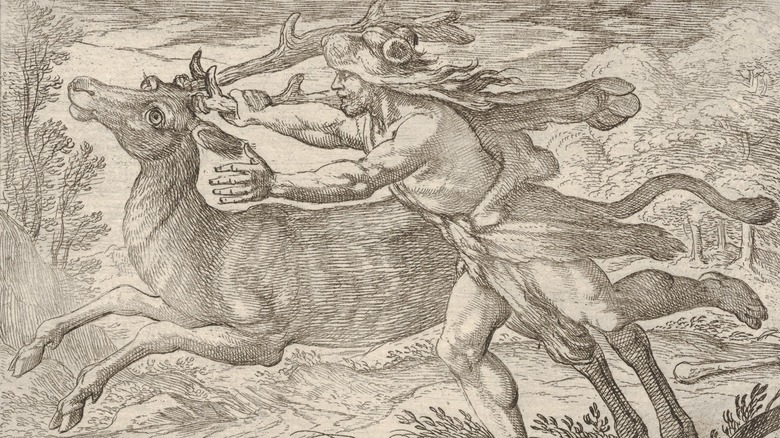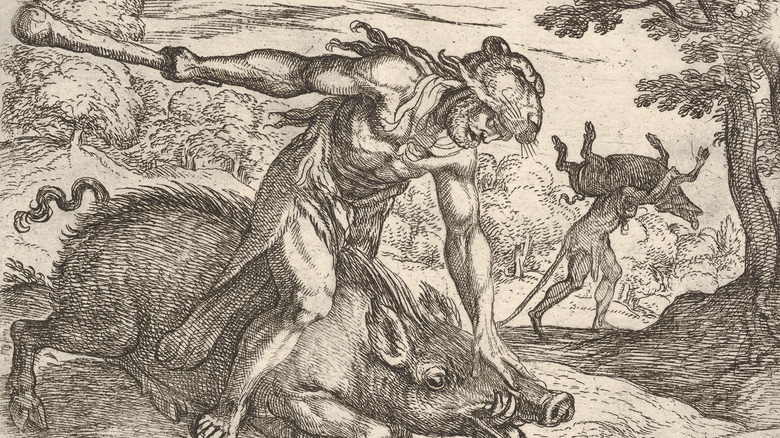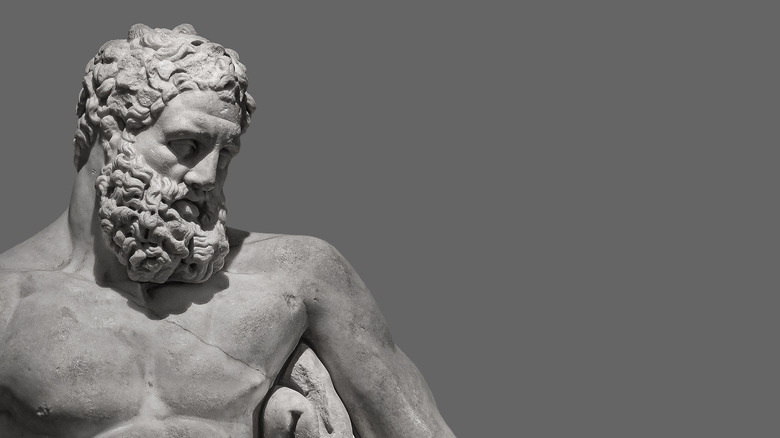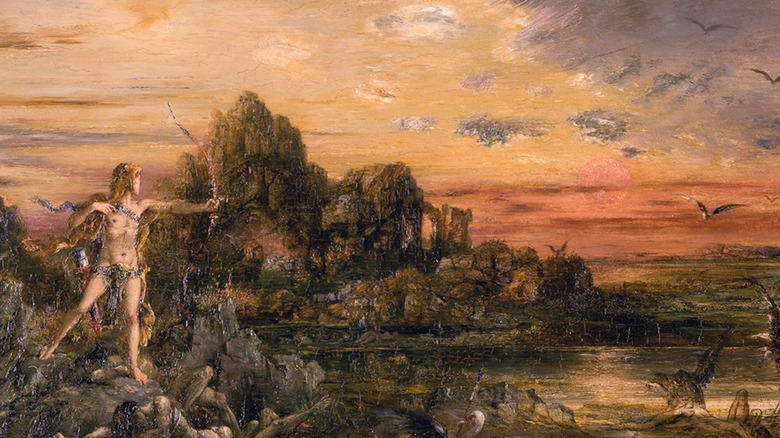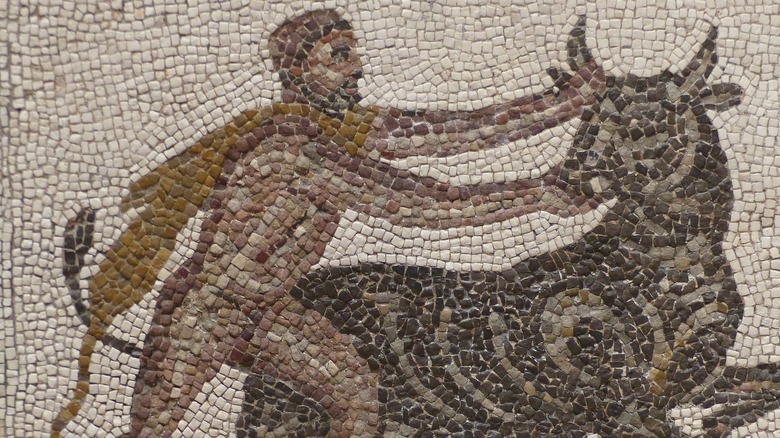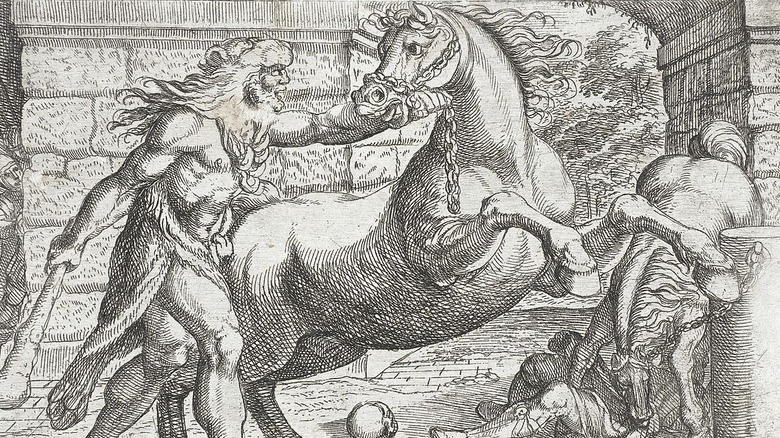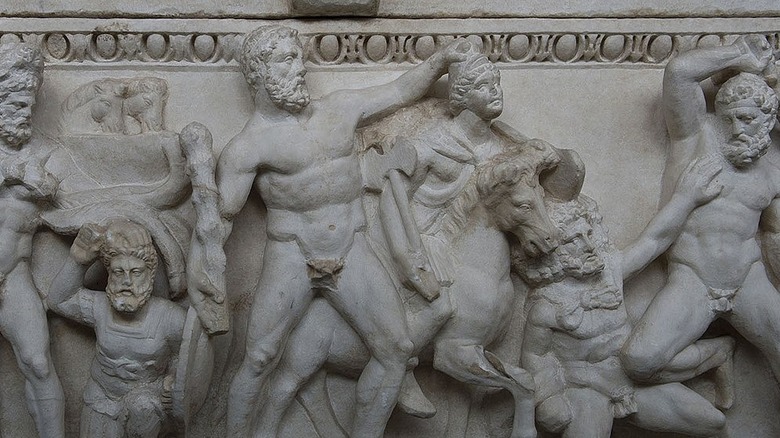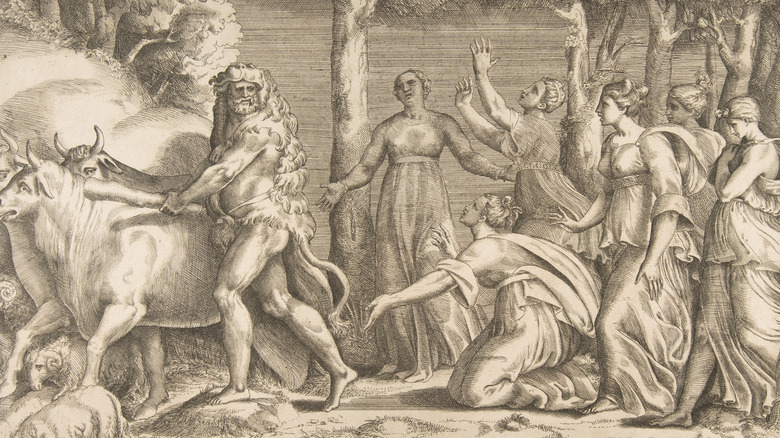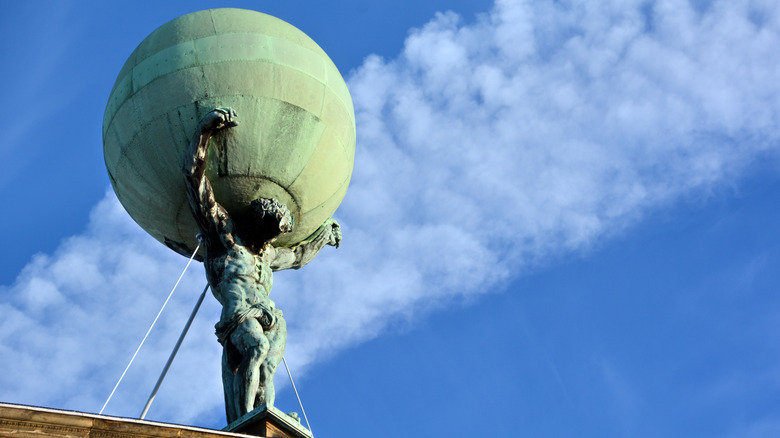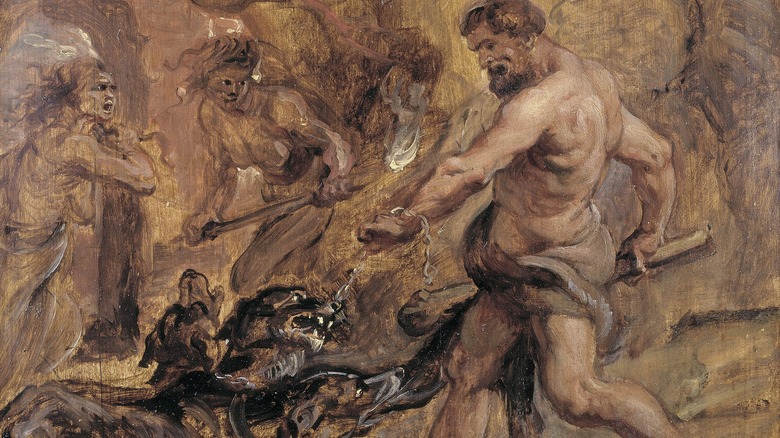The Twelve Labors Of Hercules Explained
Hercules, or Heracles, is one of the most famous figures of Greco-Roman mythology. After all, when you've had several movies, television shows, and one Disney animated film, you've got to be famous. What made him famous? It was his "Twelve Labors."
So, what happened?
According to the ancient writer Apollodorus, Hercules had gotten on the wrong side of the goddess Hera because his Zeus (her husband) was bragging about his son. Hercules was begot by Zeus and the mortal woman Alcmene. Well, Hera didn't like any of that. She made Hercules insane, and he then killed his own children. When Hercules came to his senses and realized what he'd done, he went to the Oracle of Delphi to see how he might repent. The Oracle told him that he needed to go to Mycenae and serve King Eurystheus for 12 years. If Hercules performed 10 labors for Eurystheus, his penance would be complete, and he would become immortal. King Eurystheus, for his part, hated Hercules. According to "Who's Who in Classical Mythology," Eurystheus was jealous of him and his power and would do his best to dispose of Hercules, who he viewed as a challenge to his own power.
Yes, that's right, Hercules was tasked to complete 10 labors — but we'll get to that as we explain the legendary Twelve Labors of Hercules.
Task One: Kill an invulnerable lion
Eurystheus wanted to kill off Hercules, and what could be more deadly than hunting an invulnerable lion? According to "Spirit and Reason," this beast terrorized the hills about Nemea and, in mythology, was a representation of chaos. If Hercules could kill the Nemean Lion, he could restore the natural order of the world.
As described by the Perseus Project of Tufts University, when Hercules caught up with the animal, he found that his arrows were completely useless against it. So the hero, club in hand, followed the lion to his den. Hercules blocked one of the two entrances to the cave and went in. Hercules found the club useless against the Nemean Lion, so he decided to do what any worthy son of Zeus would do — he strangled it with his bare hands. Many depictions of Hercules in classical art show him wearing a lion skin — the Nemean Lion was the owner of that hide.
When Hercules returned to Eurystheus alive, the king was so freaked out that he forbade the hero to enter his city. What's more, he had a giant bronze jar buried half in the ground to give him a place to hide.
Task Two: Slay the Lernean Hydra
Eurystheus decided that he had to give Hercules something harder to do, so he sent him to slay the Lernean Hydra. This dragon-like serpent dwelt in a cave by the swamps near the city of Lerna. According to "Python: A Study of Delphic Myth and Its Origins," the monster was huge, with up to nine heads, and breathed poison. The central head was immortal, and the Hydra had the ability to regenerate any head that was lopped off with two more.
To hunt the beast, Hercules brought with him his nephew Iolaus. According to the Perseus Project, they found the cave of the Hydra, and Hercules drew out the monster using fire arrows. Hercules charged in and grappled with the monster as it coiled about him. Hercules discovered how every time he removed one of the monster's heads, two sprung up in its place. Meanwhile, a large crab attacked Hercules' foot — something the hero quickly dispatched. (This crab would later be commemorated in the constellation Cancer.) To get out of the situation, Iolaus took a fiery torch and cauterized the severed neck each time Hercules removed a head. This prevented more heads from generating. Finally, Hercules took off the last, immortal head. He buried it on the roadside and covered with a boulder.
When Eurystheus learned of the deed, he said that this didn't count as one of the ten labors. Why? Hercules had received help from Iolaus.
Task Three: Capture a divine deer
It seems that after the Hydra, Eurystheus and Hera were furious. Straight up monsters were not getting rid of Hercules. Therefore, Eurystheus took a subtler tact. For the third labor, he ordered Hercules to capture the Ceryneian Hind. According to "The Greek Myths," the hind was a female red deer with golden antlers and bronze hooves. It was faster than an arrow that was sacred to the goddess Diana, known as Artemis in the Greek. The Perseus Project describes the conundrum. If Hercules harmed the hind, he would anger the goddess and suffer divine retribution. What was he to do?
Hercules pursued the deer for a year and finally managed to capture it using a net trap — other versions state that he tried to shoot it but ended up just catching it with his hands. Then, as he was returning to Eurystheus, Artemis showed up with her brother Apollo. It would seem that Eurystheus' plot to anger the goddess worked. However, Hercules went for the honest approach, explaining that he was doing all these labors out of penance. He promised to bring the hind back after he finished the task. Artemis forgave Hercules and allowed him to take it to Eurystheus, who wanted to put it in his menagerie. However, when Hercules released the deer, it ran away.
Task Four: Capture the Erymanthian Boar
Maybe Eurystheus was just unimaginative, but for the fourth labor, he sent Hercules again to capture a fierce monster. This one was the Erymanthian Boar. As explained by "Mythology in Our Midst," while on the long journey, Hercules encountered a centaur who gave him food and wine. As described by "Jason and the Argonauts: A Retelling in Prose of Apollonius of Rhodes' Argonautica," the wine resulted in a fight, with the centaurs being on the losing end of Hercules' wrath. However, before he killed the centaurs, he did receive advice on how to handle the fabled boar.
Hercules realized the boar's vicious tusks would murder him if he went head-on at the monster. Instead, following the centaur's advice, the hero made a din which startled the boar into flight. It ran up Mount Erymanthus, where it became trapped in snow. This allowed Hercules to grab the boar and carry it upside down to Mycenae. When he returned, he could not find Eurystheus, so, seeing a half-buried jar in the ground, he stowed the angry boar there. Little did he realize that the king was hiding there in fright of Hercules. In a rather awkward moment, both boar and Eurystheus were extracted.
Task Five: Clean the Augean Stables
Eurystheus decided to change things up for the fifth labor. According to "Myths of Greece and Rome," King Augeas of Elis owned more cattle than anybody in Greece. "Analyzing the Labours of Hercules" states that the over 1,000 head of cattle were kept in an immense stable which had not been properly cleaned in more than 30 years. Eurystheus ordered Hercules to go to Elis and clean the stables — a task seemingly impossible and mortifying if you have an ego like Hercules.
When Hercules arrived, he introduced himself to Augeas and made him an offer, according to the Perseus Project. He declared that he would clean out the huge stable in one night, and his price was one tenth of Augeas' cattle. Augeas, who had no idea that Eurystheus had sent Hercules, agreed. To do the job, Hercules dug up great trenches and altered the courses of the Alpheus and Peneus Rivers. This torrent flooded out the yard and carried all the filth away. However, Augeas refused to give up the cattle since he had found out that Eurystheus had commanded Hercules to perform this task. Hercules apparently won when a judge was asked to rule on the matter and Augeas' son admitted that his father had agreed. Augeas banished both Hercules and the son, but Hercules, after completing the labors, would later kill Augeas and give that son his kingdom. However, Eurystheus declared this labor invalid since Hercules had been paid for it.
Task Six: Shoo away a flock of vampire birds
For his next labor, Hercules had to travel to Lake Stymphalus, where, as described by "Birds in the Ancient World," there was a flock of vampiric birds that had been tormenting the area. In other accounts, as detailed by "Mythematics," the birds were merely there because they had been chased there by wolves. Nobody knows really what species of birds they were, but the book "Stymphalos" says they were supposedly about the size of a crane, with straight bills. Either way, Hercules' job was to get rid of the Stymphalian Birds.
Now, this seemed like an impossible task since there was no single monster to fight. Hercules, therefore, turned to the goddess Athena, who had helped him out in the past. She gave to him, as described by the Perseus Project, divine castanets called krotola, which had been crafted by Hephaistos. Hercules used these to make such a noise that it scared the birds into flight. He then shot them with his arrows — any survivors got the hint and flew away.
Task Seven: Corral the Cretan Bull
For the next labor, Eurystheus decided to return to more familiar ground and ordered Hercules to capture the Cretan Bull. According to Emma Stafford's "Herakles," in Greek mythology, this was a bull that carried the goddess Europa to the island of Crete, where she gave birth to King Minos. In another version, the god Poseidon sent a bull to Minos to sacrifice, but Minos decided not to, thinking the bull was too beautiful. As a result, Poseidon caused the bull to rampage about the land and Minos' wife to fall in love with it. The bull then fathered the monstrous Minotaur.
As described by the American Journal of Educational Research, Hercules arrived on Crete and received the permission of Minos to capture the bull. The king, in fact, offered to help, but Hercules refused out of pride. Compared to other tasks, this was relatively simple: Hercules snuck up behind the bull and throttled it. He sent it back to Eurystheus, who hid in his jar from the beast. Later, Eurystheus decided to sacrifice the bull to Hera, but since Hera hated Hercules so much, she refused it. According to the Perseus Project, the bull was released and afterward terrorized the people of Greece, roaming in the area of Marathon.
Task Eight: Rein in some man-eating horses
Eurystheus then ordered Hercules to capture not one beast but four. The mares of Diomedes were, as detailed in the American Journal of Educational Research, uncontrollable horses that had developed a taste for human flesh. These mares, named Podagras (the fast), Lampon (the shining), Xanthos (the blond), and Deinos (the terrible), lived, according to "A Bestiary of Monsters in Greek Mythology," in Thrace, where King Diomedes ruled over the Bistones. Diomedes was the son of the war god Ares and was himself a warlike king who fed the flesh of those he conquered to the horses, which were kept chained in iron while their bronze mangers dripped with blood. Thus, it was through Diomedes actions that the mares had become monstrous.
There are two versions of how Hercules captured the mares. One was that he went alone, and another was that he brought a group of companions. In this second version, Hercules seized the horses and entrusted them to his companion Abderus, who was, unfortunately, killed and dismembered by the horses. Meanwhile, Hercules and his men fought and killed Diomedes and his army. The horses were then brought back to Mycenae, where they were set free. They were later eaten by wild animals.
Task Nine: Seize the belt of the Amazon queen Hippolyte
Instead of a capturing a beast or slaying a monster, Eurystheus sent Hercules on a different quest for the ninth labor. The king wanted to present his daughter, Admete, with the belt of Hippolyte. Hippolyte (sometimes Hippolyta) was the queen of the Amazons, who, as described by the Perseus Project, were a tribe of female warriors whose right breasts were removed since it interfered with their spear throwing. Hippolyte's belt was a gift from Ares to the queen because of her skills as a warrior. It was worn over the queen's chest and carried her sword and spear.
Hercules traveled with companions to the Amazons, where he parleyed with the queen. Hippolyte was impressed with Hercules and promised to give up her belt. Yet before this could be done, the goddess Hera, disguising herself as an Amazon warrior, fomented discontent among Hippolyte's warriors by claiming that Hercules was going to kidnap the queen. They armored themselves and approached. Hercules, seeing the Amazons coming, thought he was betrayed and slew Hippolyte with a sword, took the belt, and then battled the Amazons. After driving them off, he returned to Eurystheus with the belt.
Task Ten: Travel to the end of the world and capture some cows
For the tenth labor, Eurystheus directed Hercules to bring to him the Cattle of Geryon. According to "Dragon: Fear and Power," these gorgeous red cattle lived far in the Western Mediterranean, upon the island of Erytheia, which was viewed by the Greeks as the end of the world. These cattle were guarded by Geryon, a three-headed monster who was the grandson of Medusa. The American Journal of Educational Research describes how Hercules crossed the deserts of northern Africa. In frustration with the heat, the hero shot an arrow at Helios, the Sun itself. Helios, admiring Hercules' cheek, gifted him with a magical golden cup which he used to help him cross the seas. When Hercules arrived on Erytheia, he was attacked by the two-headed dog Orthus. Hercules clubbed the dog to death and dispatched the herder Eurytion in the same manner. Hercules nabbed the cattle, but before he could escape, Geryon came at him in full armor. However, Hercules shot the monster with an arrow that had been poisoned with the bile of the Hydra.
Hercules also had considerable trouble on the return journey, since Hera scattered the cattle and then caused other issues. It took the hero a year to regroup them and bring them back to Eurystheus. According to the Perseus Project, it was during this labor that Hercules built two massive mountains that formed the strait of Gibraltar. These became known as the Pillars of Hercules.
Task Eleven: Pick some godly golden apples
By this point, Hercules had done ten tasks, which would have satisfied his original instructions for his penance. However, Eurystheus claimed, as explained by the American Journal of Educational Research, that neither the Hydra counted, since Iolaus helped him, nor the Augean stables, because he received payment or because the rivers did the work for him. Either way, Eurystheus wanted to squeeze two more labors out of Hercules.
His next assignment was to go and harvest the golden apples from the gardens of Hesperides. According to "Encyclopedia of Mythological Objects," these apples had been given to Hera as a wedding gift by Gaia and conferred immortality. These apples were kept in the far north and guarded by a multi-headed dragon named Ladon, as well as magical nymphs called the Hesperides.
This labor, like many of the others, has multiple versions. In one version told by the Perseus Project, Hercules first quested to find the garden until he finally located it. In order to gain the apples, however, he convinced the titan Atlas to retrieve the apples while he held up the world for him in his place. Atlas gratefully agreed, but upon returning with the apples, he told Hercules he had no intention of taking the world back upon his shoulders. Hercules then tricked Atlas again and asked him to hold up the world while he tried to make himself more comfortable. Atlas did this, but Hercules simply walked away with the apples.
Task Twelve: Kidnap the demon dog of the underworld
Eurystheus decided to go for broke since he had only one last chance to get rid of Hercules. As described by "The Mythology of the Night," he sent the hero to capture Cerberus, the three-headed (sometimes more) dog who guarded the entrance to Hades, the underworld. Cerberus also had a tail like a biting serpent as well as serpents coming from its mane, and Hercules needed to capture the dog bare-handed.
To do this, the American Journal of Educational Research tells how Hercules relied on Athena and Hermes to get into the entrance and even helped him convince Charon, the ferryman of the River Styx, to transport him. He then wrestled with Cerberus and was protected by the Nemean Lion's skin. After choking the beast unconscious, he returned from Hades with the help of Athena and Hermes to Eurystheus. He then presented the beast, which snarled back to life. Eurystheus hid in his jar screaming and demanded that Hercules return it to the Underworld. This Hercules did, completing his penance. Zeus rewarded the hero with immortality and created a constellation in his honor. Thus, the legend of Hercules was cemented in mythology forever.
